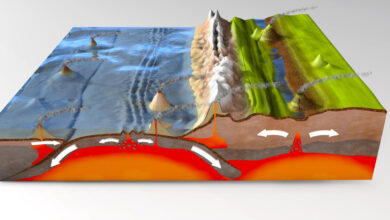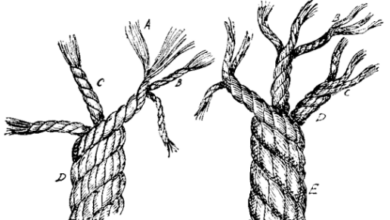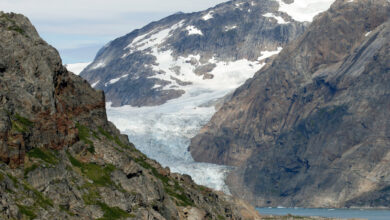A Brief History of Climate, From Prehistory to The Imaginary Crisis of the 21st Century • Watts Up With That?

Climate history clearly shows that we’re living in a blessed time, and that past civilizations generally prospered during warm periods and declined during cold ones.
By Robert Girouard
Since appearing in Africa a few hundred thousand years ago, Sapiens has had to contend with climatic changes of a magnitude and severity far beyond the benign warming we’ve experienced since the end of the Little Ice Age. These include at least two glacial-interglacial cycles, numerous major shifts in temperature and humidity, and cataclysmic eruptions such as that of the Toba volcano around 73,000 BP (yr before present), whose ashes darkened the sky for years. Thanks to his intelligence, Sapiens not only overcame all these challenges posed by a turbulent and unpredictable nature, but also became increasingly resilient, less and less dependent on the climate.
A tumultuous prehistory
From 190,000 BP onwards, our distant African ancestors first faced the Riss glaciation, followed by the Würm glaciation. Default climate during these ices ages was cold, dry and dusty, and polar at higher latitudes.
The mega-droughts that affected much of tropical Africa between 135,000 BP and 75,000 BP made life very difficult, forcing Sapiens to take refuge in the caves along the South African coast (Blombos). The Great Lakes Tanganyika and Malawi, now several hundred meters deep, remained almost completely dry for several thousand years, on several occasions.
Sapiens experienced a brief interval of favorable climate during the Eemian interglacial, which began around 130,000 BP and lasted around 15,000 years. It was significantly warmer than today, as evidenced by the disappearance of the Arctic summer ice pack and Alpine glaciers, and the greening of the Sahara. During the heat peak, the oceans were on average 2°C warmer than at present, which implies much higher temperatures on land. Some archaic Sapiens took advantage of this exceptional climatic window to leave Africa.
Between 70,000 BP and 60,000 BP, thanks to improved and wetter conditions during the last ice age, populations migrated from the coasts of South Africa to East Africa, the starting point for new exits from Africa, this time by Sapiens sapiens.
The first European Sapiens arrived around 45,000 BP (long after their Neanderthal cousins), and over the course of almost 30 millennia, the climate shifted back and forth, creating a veritable chaos. Trapped on the European peninsula, they survived some of the most brutal climatic changes of the last two million years, including a dozen sudden and pronounced warming events (Dansgaard-Oeschger events), with rises of 8°C to 10°C in just a few decades. In winter and during cold periods, the Cro-Magnon bands living in Western Europe took refuge in the valleys and caves of southern France and northern Spain. Even in these valleys, the average winter temperature was around 10°C lower than today.
During the Glacial Maximum, around 20,000 years ago, extreme cold and drought created horrific conditions almost everywhere. African lakes dried up again, deserts spread and human and animal populations collapsed. Vegetation, deprived of an adequate supply of CO2, were crying for food. Dust levels in the atmosphere were 20 to 25 times higher than today. The temperature gradient between the poles and the tropics reached 60°C, 20°C higher than today, generating monster wind and dust storms.
A salutary global warming occurred 14,700 years ago. This was the Bölling-Allerod, which lasted 2,000 years and was particularly beneficial for humans living in the Near East. In this warmer, wetter environment, where the Sahara was once again covered in vegetation, small villages sprang up and Natufian culture flourished.
This boom was suddenly interrupted by a terrible and sudden cooling, the Younger Dryas. For more than a millennium, the nascent civilization regressed. The Natufians once again became nomads, and Sapiens was forced to leave several regions that had become uninhabitable, including England, Belgium, the Netherlands and northern France.
The Holocene and relative climate stabilization
Around 11,700 years ago, our Holocene interglacial began. Temperatures warmed within a generation, vegetation greened up, lakes and rivers swelled, animals flourished… and mankind began to prosper again. And, as with the Bölling, it’s in the Near East, and more specifically in the Fertile Crescent, that civilization first bounced back. Agriculture took root, livestock farming developed in parallel, the first cities (Jericho, Çatal Höyük, etc.) came into being, while cultural innovations such as the wheel, the plough and metallurgy multiplied.
To this day, the Holocene climate has proved to be “relatively” stable, although it has oscillated between warm periods called “climatic optima”, generally favorable for humans, and cold or dark periods, generally unfavorable; these fluctuations of a few degrees in the Earth’s average temperature have been highlighted by the advance and retreat of Alpine glaciers, and other proxies.
The Thermal Optimum of the Holocene (i.e. the warmest period) stretched from 9,500 BP to 5,500 BP. However, it was not to be a long, tranquil period; among other things, the emptying of glacial Lake Agassiz caused a violent global cooling that lasted for several centuries, and its repercussions were felt as far away as the Near East, which then experienced a Little Ice Age. In the face of cold and drought, the survivors were forced into exile, notably in Mesopotamia.
When the Sumerian civilization of Ur reached its splendor, a new climatic crisis hit Mesopotamia, with drought reaching catastrophic proportions around 4,200 BP. Pastoral tribes from the surrounding mountains came down into the valleys of the Tigris and Euphrates, contributing to the decline of the Akkadian empire.
Analyses of proxies and archaeological excavations have shown that this climatic crisis was resolutely global. It was at this time that many other civilizations and empires collapsed, such as the ancient kingdom of Egypt and the Indus Valley civilization (Mohenjo-Daro, Harappa, etc.). In China, the Liangzhu culture in the Yangtze delta, among others, was destroyed by concomitant climatic changes.
Around a millennium later, other civilizations that had flourished thanks to a renewed climatic optimum were hit hard by a new episode of mega-drought, accompanied by famine and migration. We’re talking here about the new empire of Egypt, the Cretan and Minoan civilizations, the Hittite empire, the kingdoms of Mycenae and Ugarit, to name but a few. Within fifty years, they all collapsed, along with the trade networks they had established. The causes of this civilizational debacle known as the Late Bronze Age Collapse are undoubtedly manifold – think of the invasions of the Sea Peoples – but climate change was certainly a factor. The dark ages that followed, which forced Sapiens to adapt once again, marked the transition from the Bronze Age to the Iron Age, demonstrating that adverse climatic change need not be a brake on progress.
From 250 BCE (before common era) onwards, a new optimum, known as “Roman” or “Classical”, created conditions conducive to the rise of the great Greco-Roman and Carthaginian civilizations (later absorbed by Rome), on whose ashes Western civilization was later built. The Mediterranean basin is described as an Eden where life is good, and high agricultural yields supply Rome, whose idle population exceeded one million. According to a recent study, this was the hottest period in the last two millennia , and a well-watered one at that. In the absence of sufficient data, it is uncertain whether this optimum extended beyond the Roman world.
From the fall of Rome to the Little Ice Age
Various factors contributed to the fall of Rome. But historian Kyle Harper claims that the collapse was mainly due to successive epidemics and a deteriorating climate. Temperatures began to cool around 250 CE or even earlier. A dozen proxies such as ice cores, glacier advances, pollens and marine and lake sediments attest to the reality of this cooling, to which we must add the writings of the time and other basic data such as solar variations. The granaries of Africa and Sicily dried up, causing famines. The steppes of Central Asia suffered severe drought, leading to migrations by the Huns, who in turn led the Goths to invade Rome.
Conditions seem to have worsened during the Little Ice Age of Late Antiquity, from 536 to 660, which may have contributed to the establishment of the Justinian plague, transformation of the eastern Roman Empire and collapse of the Sasanian Empire, movements out of the Asian steppe and Arabian Peninsula, spread of Slavic-speaking peoples and political upheavals in China.
America was not spared by climate change, though it manifested itself in different ways. The fall of Teotihuacan, the largest pre-Columbian city, around 550 coincided with a change in the monsoon regime in the Mexico basin. In the Yucatan, several Mayan cities also succumbed to the onslaught of drought, despite all the human sacrifices and other barbaric rites devised by the elites to appease the rain god Chaac.
After six centuries of hard times, the gentle way of life returned from 900 onwards. During this Medieval Optimum, which lasted around four centuries punctuated by ups and downs, Europe experienced unprecedented demographic, economic and cultural growth. Countless written sources studied by talented historians such as Emmanuel Le Roy Ladurie confirm the reality of this warm period. At times, the weather was warm enough for Northern England to produce excellent, exportable wine, and vines were grown as far away as East Prussia and southern Norway. Agricultural surpluses helped finance the Crusades, cathedral construction and the arts in general. Morals also softened, with the advent of courtesy and the spirit of chivalry.
At the same time in China, the Song civilization was flourishing, by far the most sophisticated and advanced of its time. It was responsible for the construction of extensive canal systems, large bridges and trading ports, as well as the invention of gunpowder, the compass and printing. The art of living reached an unprecedented level of refinement. The Songs were also the first to develop a metallurgical industry using blast furnaces. Their giant warships, powered by paddlewheels and able to accommodate a thousand soldiers, were unrivalled. However, they were defeated in 1279 by the Mongols, who also benefited greatly from the good weather in Central Asia, marked by high rainfall.
In South America, the expansion of the Inca Empire coincided with a significant rise in temperatures in the central Andes between the 12th and 16th centuries. Thanks to this warming and the irrigation made possible by melting glaciers, the Incas were able to substantially increase their agricultural land by terracing the mountain slopes. The resulting surpluses enabled them to build their impressive communication networks and feed their huge armies to carry out their military campaigns.
Medieval warming spread to such northern lands as Iceland, Greenland and Newfoundland, where the bold Vikings succeeded in establishing more or less durable colonies. The two communities established on the coast of Greenland held out for several centuries, until the cold returned. Being breeders and beer-drinkers, the Vikings would not have stayed so long if they hadn’t been able to grow grains and barley. Today, however, Greenlanders are still struggling to grow potatoes. Similarly, the discovery under an Alaskan glacier of the remains of a 1,000-year-old forest suggests that temperatures there were also higher than today.
Then came the Little Ice Age, which began in Europe in 1300 and brought its share of misery, famine, epidemics, migrations, revolts and more. The population was halved by the plague and the deleterious effects of climate change, and took a century to recover. Between 1560 and 1630, Alpine glaciers began to advance rapidly during the Grindelwald Fluctuation. The middle of the 17th century was one of the coldest periods of the Holocene. People skated on the canals of Holland and Belgium depicted by Brueghel father and son, while fairs were held on the frozen surface of the Thames until 1814. The most famous of these frost fairs took place during the Great Freeze of 1683-84, when the Thames remained completely frozen for two months.
Numerous historical testimonies from this period attest to the severity of the Little Ice Age, which was not limited to Europe but probably global. Among others, including the Khmer kingdom of Angkor, Ming China was hit even harder, the worst occurring in the 1640s when a powerful volcanic eruption exacerbated climate change.
One of the most sordid and striking cultural manifestations of this troubled period was undoubtedly the witch-hunt in Europe. This movement of “extraordinary popular delusion”, which consisted in accusing perfectly innocent people – poor old women in particular, but also Jews, homosexuals and the mentally ill – of witchcraft, and holding them responsible for all the evils that plagued society, was mainly observed in Germany, Switzerland and northern France, and reached its climax in the years 1560 to 1650.According to various estimates, between 50,000 and 100,000 witches and sorcerers were tortured, hanged or burned to protect society from their supposed misdeeds. All with the blessing of the civil and religious elites, both Catholic and Protestant.
That said, this period of history wasn’t all doom and gloom; it also saw many dazzling innovations, notably in agriculture, architecture and medicine, and even spectacular advances in civilization such as the Renaissance, the Great Discoveries, the Enlightenment and the Industrial Revolution. It was also during this cold period that the Dutch Golden Age flourished: thanks to their resilience, adaptability and creative opportunism, the 17th-century Netherlands was able to turn climate change to its advantage and rise to become the world’s leading trading power.
The modern optimum and the imaginary climate crisis
For obvious reasons, and whatever the causes, the global warming that followed the Little Ice Age (officially ended in 1850) came as a relief, since it eased the suffering of the cold and ushered in a new Eden similar to the Roman or medieval optimum. We must also never forget that we are living in the neoglacial phase of an interglacial…
Although some believe that warming began after the trough of the Little Ice Age, around 1750, as suggested by the early retreat of Glacier Bay glaciers, it wasn’t until 1910 that we saw the first sustained surge, lasting 30 years, followed by a slight cooling until the early 1970s, and then a second warming surge quite similar to the first, ending in 2000. A heat peak was reached in 1998-1999 and another, one iota higher, in 2015-2016, both corresponding to powerful El Nino events. A new record will undoubtedly be broken during the current El Nino.
In all, the global average temperature has risen by around 1.15°C over some 170 years, which, as we have seen, is by no means exceptional given the climatic upheavals of the past. In addition to its margin of error, this “global average temperature” makes little sense, since there is no single Earth climate, but rather a panoply of regional and local climates with a wide variety of characteristics. How can we average the climate of Antarctica with that of Amazonia? We also know that land warms up more than oceans, the northern hemisphere more than the southern, mid and high latitudes more than the tropics, and cities more than their countryside (i.e. the urban heat island phenomenon). Some climates are benefiting from the warming, while others remain inhospitable.
Like all the others that preceded it, this new optimum has been generally beneficial for mankind. Today in fact, humanity finds itself in a situation incomparable to that of 1850. The world’s population has now reached 8 billion, compared with 1.2 billion at the start of the industrial era. Food production has more than kept pace, as famine has been virtually eliminated, a feat in itself; in fact, thanks to the Green Revolution, agricultural yields are exceeding all expectations. Average life expectancy has almost doubled, and infant mortality has been divided by 10. Wealth has increased exponentially, while extreme poverty has declined dramatically throughout the world Added to this are all the marvels of science, technology, medicine, transport, communications, architecture, the arts and entertainment, to name but a few, that make life so enjoyable for a growing number of human beings.
That said, climate being what it is, there have been painful episodes in certain regions of the world. In the 1930s, for example, the northern hemisphere was plagued by extreme heat waves and drought. The year 1936 still ranks as one of the hottest on record in the USA. During the Dust Bowl, the Western Great Plains were also devastated by appalling sandstorms, with dramatic consequences for the people who lived there. Such droughts, often interspersed with periods of heavy rainfall, have been recurrent over the last millennia, and there will certainly be more to come.
Likewise, the slight global cooling of the 1950s and 1960s, particularly present in the Arctic and sub-Arctic regions and extending from Europe to China, raised fears of the advent of a new Ice Age. Population Bomb author Paul Ehrlich and future Obama science advisor John Holdren wrote in a book about “the risk of a sudden shift in the Antarctic ice cap induced by an overload of ice”. With the return of warmer temperatures, these exaggerated fears faded, but only to be replaced, a few decades later, by even more alarmist predictions, this time linked to “Catastrophic Anthropogenic Global Warming”.
At a time when life on Earth has never been so easy, part of the human race, concentrated in wealthy Western countries with a Judeo-Christian tradition, has got it into its head that current global warming is different in that it’s bad, and must be stopped before it drags the planet into irreversible climatic hell. As in the days of the witches, a scapegoat has been designated: fossil fuels. In the words of UN Director-General Antonio Guterres, “fossil fuels are incompatible with human survival”. This is because they are responsible for everything that supposedly goes wrong on the planet: heat waves, torrential rains, cold snaps, hurricanes, tornadoes, floods, droughts, forest fires, loss of biodiversity, declining polar bears, disappearing coral reefs, epidemics, and so on.
This irrational fear, fueled by pseudo-scientists and idiotic or unscrupulous elites, is all the more incomprehensible given that Sapiens has never been so well-equipped to cope with climate change and the vagaries of the weather – two very different things, by the way, and which are in no way abnormal. In fact, the drastic fall in weather-related deaths has continued unabated since 1900.
However, the real danger facing humanity lies in the drastic solutions proposed by the proponents of climate catastrophism. These involve the forced elimination of fossil fuels by 2050 and their replacement by so-called renewable energies, mainly wind and solar power, which presupposes a radical transformation of the material economy. Not only would humanity be depriving itself of the undeniable advantages of fossil energies – abundant, inexpensive, versatile, easy to transport and store and, above all, available at all times – but it would also be jeopardizing its future, given the well-known shortcomings of wind and solar power – low density, intermittence, randomness due ironically to the vagaries of the weather, impact on the stability of electricity grids, need for back-up systems, etc. In fact, because of its staggering costs and risks to the continuity of energy supply and the functioning of the economy, this hasty transition, imposed by restrictive policies, could mean the weakening or even collapse of modern post-industrial civilization as we know it.
So, for the first time in history since the advent of Sapiens, a highly advanced civilization is in danger of disappearing during a perfectly acceptable climatic optimum, due to a totally fictitious and imaginary “climate crisis”! Our descendants won’t believe it! Fortunately, this won’t happen, because “extraordinary popular delusions” are always unmasked in the end. There are signs that this could happen soon. Let’s hope so.
Acknowledgement: This article is based on well-established geological and historical facts, but it owes much to the excellent synthesis by Olivier Postel-Vinay, in his book Sapiens et le climat – Une histoire bien chahutée, Les Presses de la Cité, 2022




